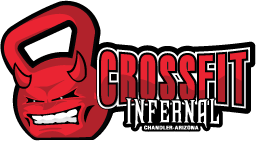I am recently back from CrossFit’s Level 1 Certification in Denver, CO and I swear that it was the lack of oxygen in the mile high city that made my wod time so pathetic (that’s my story and I am sticking to it!) This two-day certificate course presents the basic concepts that underpin the CrossFit approach of “constantly varied, high intensity, functional movements” along with a break down of the nine foundational movements in terms of their set-up and key points of performance.[1]
I did not take the course with the specific intent to coach, but rather wanted a better understanding of how CrossFit HQ presents their training and information to those potentially about to be new coaches or affiliate owners. Having jumped around amongst a number of the boxes in the East Valley and having had the opportunity to train at any number of boxes while traveling, I had seen a wide variety of approaches to coaching and wanted a better understanding of what CrossFit HQ was actually laying down.
I was very pleased to discover the Level 1 course was much more rigorous than I anticipated, both in terms of the level and depth of information presented on technique, mechanics, nutrition, etc. and the efforts put in by the training staff to hone basic coaching skills, presentation styles and the ability to spot errors and correct them through a variety of approaches.
But one of the concepts that struck me most in those two days was what exactly it means to train at threshold and what that means to the individual athlete. Training at threshold takes an athlete to just the limit of where technique, speed and mechanics start to break down. And then if we are smart, it also means slowing down, backing up and working at that limit so the athlete can push through to the next level.
Training at threshold is where the “gainz” happen.
Many of us walk into the gym and check out the Rx weight and start loading our bars. But rarely do we ever think about where we are individually in terms of our training and what our individual, specific Rx weight should be – and that might be higher or lower than Rx. During the Level 1 course we talked about what a wod needs to look like for an athlete to be at threshold. Here’s a hint – it is not all the times I have had to stop a wod, bent over and resting on my knees to the point where Coach Vanessa walks over to see if I am actually going to need CPR. But it’s also not a daisy walk in the park where every single rep is picture perfect (unless your name is Rich Froning, of course) and you break a slight sheen but don’t really push yourself too hard.
One definition of threshold that was offered was that if you are doing 80%-85% of your reps in a wod with great technique and mechanics and start losing the proper depth of squat as you get tired or your elbows are not coming through all the way in the cleans on the third round of a 4 round wod – congratulations! You are at your threshold and are training well. And, most importantly to almost all of us, that’s where your gainz come from – those final few reps, not the prettiest, not the most perfect, but the ones where you really give it your all to make it happen (if you train with Coach Nick you will instantly recognize this as the “pshup, pshup, pshup” moments.)
However, there is of course a dark side to the issue – what if 80% of your reps are mechanically faulty? What if you are finishing in record time, but you never squat below parallel other than those first 8 reps? Or you never quite hit the mark on the wall? Or your chin never quite sees the light of day over the bar? Not only are you not getting gainz, but you are also teaching your body the wrong movements. Don’t believe me? Check out this post that Coach Nick shared on Facebook at No Rep Muscle Memory
There is a reason we repeat movements over and over and over. There is a reason that we review movement patterns of specific pieces of the wod long after we know every one in the room knows them by heart – repetition counts. The only way your body learns these movements and patterns is by repeating them. Repeat them over and over correctly – you will get better, you will train at your threshold and you will get gainz. Repeat them over and over incorrectly – you will not get better, you won’t get as many gainz and may, over time, cause yourself injury.
So the next time an Rx weight seems too light, or too heavy, don’t be afraid to change it. Or even perhaps stay at the Rx weight but reduce the number of reps or rounds so you can pull off the wod at the suggested Rx weight (but admit to that when you get to the whiteboard!) Or a Coach walks by and suggests you try something at a lower weight, or offers that your chest is dropping too far forward in a squat or that your wallball squat is not going below parallel – take note and consider they may just see something you can’t and whether you are maybe working beyond your threshold. It’s not fun, it’s not ego boosting – but I survived a lot of CrossFit HQ staff telling me I needed to drop about a half inch lower in my squat, so I know you’ll survive as well.
[1] The nine foundational Crossfit movements are squats, front squats, OHS, shoulder press, push press, push jerk, dead lift, sumo deadlift high pull and medicine ball clean. All else follows from there.
